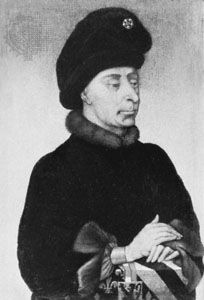John
- Byname:
- John The Fearless
- French:
- Jean Sans Peur
- Born:
- May 28, 1371, Rouvres, Burgundy
- Died:
- Sept. 10, 1419, Montereau, Fr. (aged 48)
John (born May 28, 1371, Rouvres, Burgundy—died Sept. 10, 1419, Montereau, Fr.) was the second duke of Burgundy (1404–19) of the Valois line, who played a major role in French affairs in the early 15th century.
The son of Philip the Bold, duke of Burgundy, and Margaret of Flanders, John was born in the ducal castle at Rouvres, where he spent the greater part of his childhood. In 1385 he married Margaret of Bavaria, and in the following decade his father initiated him into the arts of government and warfare, though he was not given any post of responsibility. Even in 1396, at the age of 24, when he became leader of the Burgundian crusade against the Ottoman Turks in defense of Hungary, his leadership was only nominal. The actual conduct of the expedition, which ended in the disastrous defeat of the crusaders on the battlefield of Nicopolis and the capture of John by the Turks (an adventure that earned him the epithet the Fearless), was entrusted to a group of councilors and military advisers appointed by Philip the Bold. John evidently benefited from the blunders of these commanders, for his subsequent career showed that he was the only one of the Valois rulers of Burgundy who knew how to handle an army.
When John at last succeeded his father in 1404 as duke of Burgundy and count of Burgundy, Flanders, and Artois, he was 33 years old.
John the Fearless spent most of his time and his considerable political and military energies in France, Paris being his normal place of residence and seat of government. His only significant personal participation as duke of Burgundy in major events outside France took place in 1408, when he led a Burgundian army to aid his beleaguered brother-in-law, the bishop of Liège, John of Bavaria, against the citizens of Liège, who were in open revolt. On the field of Othée, on Sept. 23, 1408, the men of Liège were decisively defeated, and Burgundian influence was extended over the city and over the bishopric of Liège. From the start, then, John found himself involved in French affairs and was in part responsible for provoking a civil war in France with a rival house, headed by his first cousin, the King’s younger brother, Louis, duc d’Orléans. Each man sought control of the mad king Charles VI and his queen and of the capital Paris. While the notorious murder by Duke John of his cousin by hired assassins in 1407 enabled John to subdue Paris and the crown, the opposition to the Burgundians by Louis’s followers and heirs continued. Their faction was named after its main supporter, Bernard VII, comte d’Armagnac.
During the five years between 1413 and 1418, in which the Armagnacs succeeded in driving the Burgundians out of Paris, the internal situation in France was further complicated by a new English invasion led by the ambitious king, Henry V. Duke John was one of those French princes who, while pretending to do his best to reach the battlefield of Agincourt to give battle to the English (1415), was unaccountably delayed on the way. His intermittent negotiations with King Henry V did not, however, lead to a firm Anglo-Burgundian alliance, and in the autumn of 1419 John turned instead to the Armagnacs, in the hopes of arranging a truce or even making a firm peace settlement with their youthful leader, the dauphin Charles (the future Charles VII), in an alliance against the English. The two princes, each with 10 companions, met on the bridge of Montereau, some 50 miles southeast of Paris. As the diplomatic parley began, John the Fearless was struck down and killed during a dispute started by the Armagnacs, a political assassination that contemporary evidence shows was almost certainly carefully premeditated.
John pursued aims similar to those of the other rulers of his day: the consolidation and extension of his own and his family’s power. In spite of his lapses into violence, his love of intrigue, his hypocrisy, and his rashness, he was a successful diplomat and military leader; he was more dynamic and more of a reformer than his son Philip the Good and more cunning, though less scrupulous, than his father. Yet he has received less attention from historians than either of them. In the eye of history, especially French history, he has long been regarded as a traitor and assassin. There was, perhaps, a dark and sinister element in his character, but he lived in an age when vice, tyranny, and murder were the common properties of every ruler. If he wrought destruction in France, he also brought peace and prosperity to his own Burgundian lands.











